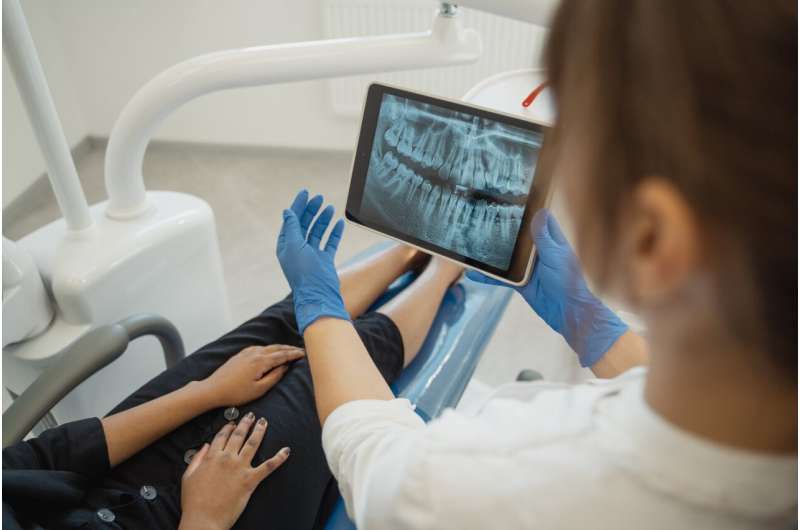This article has been reviewed according to Science X's editorial process and policies. Editors have highlighted the following attributes while ensuring the content's credibility:
fact-checked
peer-reviewed publication
trusted source
proofread
Getting X-rays at the dentist? It's safer than you realize

Since dental X-rays became commonplace some seven decades ago, dentists and hygienists have been draping their patients with protective gear to shield them from the possibility of radiation exposure to body parts other than the jaw. But experts in dental radiology say it's time to hang up those lead aprons for good.
The digital radiograph equipment used in dental offices today is lightyears away from that of past generations, and the amount of external radiation scatter, as it's known, from modern X-ray technology poses little to no threat to patients, according to the American Academy of Oral and Maxillofacial Radiology (AAOMR). The organization has recommended that lead aprons and thyroid shields do not need to be used routinely for dental X-rays.
"There is ample evidence in scientific literature that shows that the apron and thyroid collar do not provide any additional benefit," says Aruna Ramesh, professor and associate dean for academic affairs at Tufts University School of Dental Medicine (TUSDM). Ramesh, a specialist in dental radiology, is a co-author on an article outlining the AAOMR's new recommendations, which was published in August in The Journal of the American Dental Association.
The negligible radiation exposure a dental patient receives to areas away from the head comes through "internal scatter," in which a small amount of the radiation that enters through the head and neck, the area targeted by the X-ray machine, bounces to other parts of the body, Ramesh says. "The internal scatter that exposes the organs below the jaw cannot be prevented with an apron."
In fact, Ramesh says, it's possible an apron or collar can interfere with getting a clear shot of the jaw, making it necessary to try a second time, doubling the overall dose. "Preserving the quality of the images is the best way we have of protecting our patients," says Hugo Campos, associate professor and director of oral and maxillofacial radiology at TUSDM.
Despite this, you probably won't see big changes at your next dental appointment. Most states have regulations requiring protective gear during dental X-ray procedures, and until those rules are amended—which will need to happen on a state-by-state basis—dental teams will most likely continue using aprons and shields.
And, as states eventually update their policies, the focus for dentists should be on ways to communicate clearly with their patients about the rationale for the change and the data behind it, according to Ramesh.
Patients at physicians' offices, hospitals, and medical facilities where other parts of the body are X-rayed will encounter a similar patchwork of regulations, says Anthony Blatnica, assistant professor of radiology at Tufts University School of Medicine and chair of the radiation safety committee at Tufts Medical Center. That X-ray equipment also produces little, if any, external scatter.
"If it's not in the primary beam, you're only dealing with internal scatter. And so external shielding doesn't make sense," Blatnica says. And, if any part of the covering creeps into the field of the X-ray and obscures anatomy, "that's where it becomes problematic," he says.
Meanwhile, there's another wrinkle to abandoning the apron: For some dental patients, it provides a level of comfort, whether physical—think of a weighted blanket—or mental. "The lead apron plays a very important role in the psychology of our patients," says Campos. "They feel that you are protecting them," not realizing that current radiograph techniques and technology provide adequate safeguards.
Pregnant people and parents of pediatric patients tend to show particular concern about possible radiation exposure. In both cases, Campos says, "the same dose is received with the shield as without the shield—and that is extremely low."
For example, according to the article, the dose of radiation exposure from dental X-rays to a developing fetus would have to be 10,000 to 30,000 times higher than it is to risk causing conditions such as microcephaly, growth retardation, or intellectual disability. "However, we know some pregnant patients are going to feel more comfortable and protected when they have the lead apron," says Campos.
More information: Erika Benavides et al, Patient shielding during dentomaxillofacial radiography, The Journal of the American Dental Association (2023). DOI: 10.1016/j.adaj.2023.06.015





















